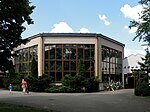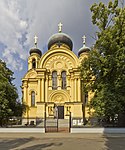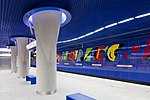Church of Our Lady of Loreto
1642 establishments in the Polish–Lithuanian Commonwealth17th-century Roman Catholic church buildings in PolandBaroque church buildings in PolandRoman Catholic churches completed in 1642Roman Catholic churches in Warsaw

The Church of Our Lady of Loreto (Polish: Kościół Matki Bożej Loretańskiej) is an ornate church in Praga, a district of Warsaw, Poland, on the east bank of the Vistula River. The church stands on Ratuszowa (City Hall) Street and is Praga’s oldest monument. What may be seen today is a former chapel that on its south side was once attached to a baroque church and a Bernardine (Minor Friars) monastery.
Excerpt from the Wikipedia article Church of Our Lady of Loreto (License: CC BY-SA 3.0, Authors, Images).Church of Our Lady of Loreto
Ratuszowa, Warsaw Praga-Północ (Warsaw)
Geographical coordinates (GPS) Address External links Nearby Places Show on map
Geographical coordinates (GPS)
| Latitude | Longitude |
|---|---|
| N 52.2567 ° | E 21.0277 ° |
Address
Kościół pw. Matki Bożej Loretańskiej
Ratuszowa 5A
03-461 Warsaw, Praga-Północ (Warsaw)
Masovian Voivodeship, Poland
Open on Google Maps











